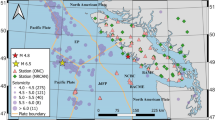Abstract
A rational choice of the scalar seismic moment and ordering index is proposed that can be advantageously used for the monitoring of source zones of strong earthquakes in order to predict the development of a seismic situation. These parameters are the main characteristics of seismotectonic deformation. The ordering index characterizes a regular change in time of chaotization and ordering phases of the seismic process related to the occurrence of strong aftershocks. Using the December 5, 1997, Kronotskii (M w = 7.8) and December 26, 2004, Sumatra (M w = 9.0) earthquakes as an example, temporal variations of the studies parameters in the aftershock zones of these earthquakes are analyzed in detail.
Similar content being viewed by others
References
A. V. Deshcherevsky, A. A. Lukk, and A. Ya. Sidorin, “The Origin of Temporal Variations in Geophysical Fields,” in Geophysics at the Century Boundary: Selected Papers of Scientists of the Institute of Physics of the Earth, Russian Academy of Sciences (OIFZ RAN, Moscow, 1999), pp. 194–215 [in Russian].
A. M. Dziewonski, T. A. Chou, and J. H. Woodhouse, “Determination of Earthquake Source Parameters from Wave-Form Data for Studies of Global and Regional Seismicity,” J. Geophys. Res. 86, 2825–2852 (1981).
S. A. Fedotov, Energy Classification of Kurile-Kamchatka Earthquakes and the Problem of Magnitudes (Nauka, Moscow, 1972) [in Russian].
G. A. Gamburtsev, “The State and Perspectives of Research on Earthquake Prediction,” Byul. Soveta po Seismol. Akad. Nauk SSSR, No. 1, 7–16 (1955).
H. Kanamori, “The Energy Release in Great Earthquakes,” J. Geophys. Res. 82, 2981–2987 (1977).
B. V. Kostrov, Mechanics of a Tectonic Earthquake Source (Nauka, Moscow, 1975) [in Russian].
A. A. Lukk and S. L. Yunga, Geodynamics and the Stress-Strain State of the Central Asia Lithosphere (Donish, Dushanbe, 1988) [in Russian].
A. A. Lukk and S. L. Yunga, “Wave Disturbances in the Seismotectonic Stress-Strain State Reconstructed from Focal Mechanisms of Earthquakes,” in Dynamic Processes in a Geophysical Medium (Nauka, Moscow, 1994), pp. 21–39 [in Russian].
A. I. Lutikov, “On the Reconstruction of the Relation between the Energy Class and the Magnitude M S for Earthquakes of the Kamchatka Region,” Vulkanol. Seismol., No. 6, 44–46 (1999).
A. I. Lutikov, “Seismic Regime of the Tien Shan in Terms of Seismotectonic Strain,” in Proc. All-Russia Workshop “Geomorphology of Mountains and Foothills.” Barnaul-Gorno-Altaisk, September 24–30, 2002, pp. 172–179 [in Russian].
A. Lutikov, “Seismicity Monitoring of Six Strong Earthquakes Source Areas (1976–2001) by One Seismic Moment Tensor Invariant in Different Regions of the World,” in European Geophysical Society. 27th General Assembly. Geophysical Research Abstracts, 2002, Vol. 4 (CD).
A. Lutikov, “Seismic Monitoring of Strong Earthquakes Source Areas,” in IV International Biennial Workshop on Subduction Processes Emphasizing the Japan-Kurile-Kamchatka-Aleutian Arc. Petropavlovsk-Kamchatski, August 21–27, 2004, pp. 239–240.
A. I. Lutikov, “Preliminary Seismological Analysis of the Catastrophic Earthquake of December 26, 2004 (M w = 9) in Southeastern Asia,” in Active Geophysical Monitoring of the Earth’s Lithosphere. II Int. Symposium. Proc. Int. Confer. September 12–16, 2005 (Novosibirsk, 2005), pp. 401–406 [in Russian].
A. Lutikov and M. S. Kuchay, “Seismicity Time Variation in the Areas of Occurrence of a Number of Strong Earthquakes in the North Caucasus, J. Earthquake Prediction Res. 7(1), 76–82 (1998).
A. I. Lutikov, G. Yu. Dontsova, and S. L. Yunga, “Seismological Analysis of the Altai Earthquake of 2003,” in The Strong Earthquake of September 27, 2003 in Altai (Moscow, 2004), pp. 38–49 [in Russian].
V. I. Myachkin, B. N. Kostrov, G. A. Sobolev, and O. G. Shamina, “Fundamentals of Source Physics and Earthquake Prediction,” in Physics of an Earthquake Source (Nauka, Moscow, 1975), pp. 6–29 [in Russian].
C. F. Richter, Elementary Seismology (Freeman, San-Francisco, 1958; IL, Moscow, 1963).
E. A. Rogozhin, “Historical Seismicity of Seismogenic Structures of Northern Eurasia in the Holocene,” Dokl. Akad. Nauk SSSR 370(3), 390–392 (2000).
E. A. Rogozhin, “A Global Natural Catastrophe in the Indian Ocean,” Geografiya, No. 2, 8–13 (2005).
E. A. Rogozhin and A. I. Zakharova, “Paleoearthquakes and the Seismic Regime of the Mountainous Altai in the Holocene,” Dokl. Akad. Nauk SSSR 388(6), 809–811 (2003).
E. A. Rogozhin, A. I. Zakharova, and A. N. Ovsyuchenko, “Paleoseismogeological Studies in the Elbrus Area and the Long-Term Seismic Regime,” in Fedynskii Eighth Geophysical Workshop. March 2–4, 2006. Abstracts (Moscow, 2006), [in Russian].
G. A. Sobolev, Fundamentals of Earthquake Prediction (Nauka, Moscow, 1993) [in Russian].
G. A. Sobolev and A. V. Ponomarev, Physics of Earthquakes and Precursors (Nauka, Moscow, 2003) [in Russian].
C. Truesdell, A First Course in Rational Continuum Mechanics (The Johns Hopkins University, Baltimore, 1972; Mir, Moscow, 1975).
D. L. Turcotte, “Seismicity and Self-Organized Criticality,” Phys. Earth Planet. Inter. 111, 275–293 (1999).
S. L. Yunga, Methods and Research on Seismotectonic Deformations (Nauka, Moscow, 1990) [in Russian].
S. L. Yunga, “Retrospective Analysis of Temporal Variations in Seismic Moment Tensors in the Shikotan Earthquake Zone,” in Federal System of Seismological Observations and Earthquake Prediction. Information and Analysis Bulletin (MChS RF and RAN, 1996), Nos. 1–2, pp. 83–89 [in Russian].
S. L. Yunga, “Comparative Analysis of Seismotectonic Deformations in Regions of Active Geodynamic Regimes,” in Geophysics at the Century Boundary: Selected Papers of Scientists of the Institute of Physics of the Earth, Russian Academy of Sciences (OIFZ RAN, Moscow, 1999), pp. 253–264 [in Russian].
A. I. Zakharova and E. A. Rogozhin, “Deep-Seated Precursors of Strong Seismic Events in the Kamchatka Region,” in Geophysics at the Century Boundary: Selected Papers of Scientists of the Institute of Physics of the Earth, Russian Academy of Sciences (OIFZ RAN, Moscow, 1999), pp. 265–275 [in Russian].
Author information
Authors and Affiliations
Additional information
Original Russian Text © A.I. Lutikov, 2008, published in Fizika Zemli, 2008, No. 3, pp. 9–21.
Rights and permissions
About this article
Cite this article
Lutikov, A.I. Seismic monitoring of source zones of strong earthquakes. Izv., Phys. Solid Earth 44, 181–192 (2008). https://doi.org/10.1134/S1069351308030026
Received:
Published:
Issue Date:
DOI: https://doi.org/10.1134/S1069351308030026




